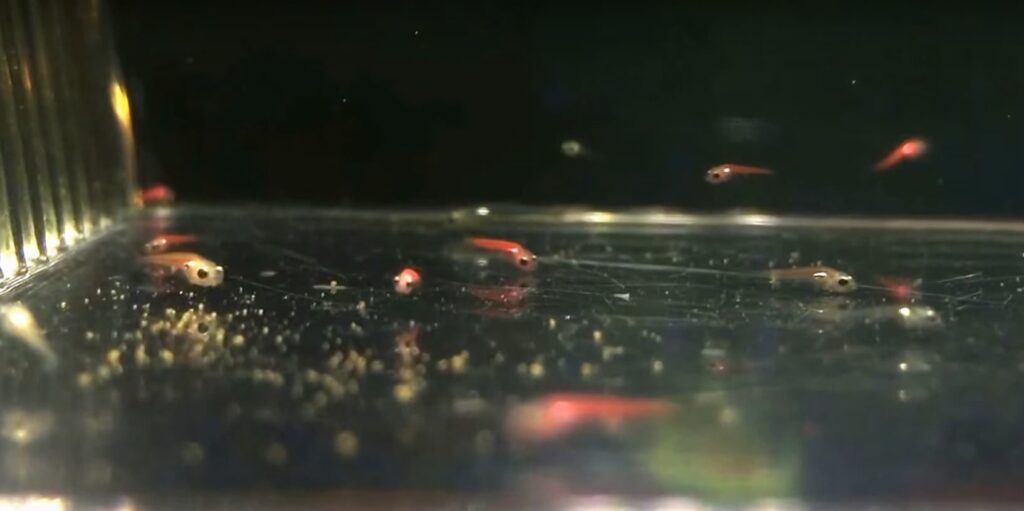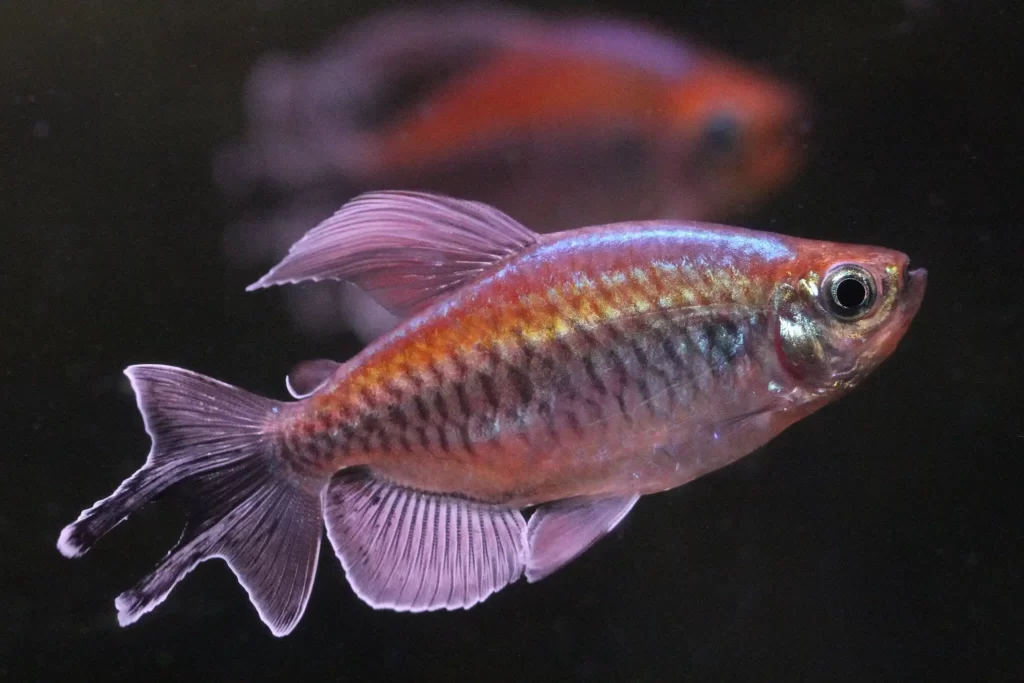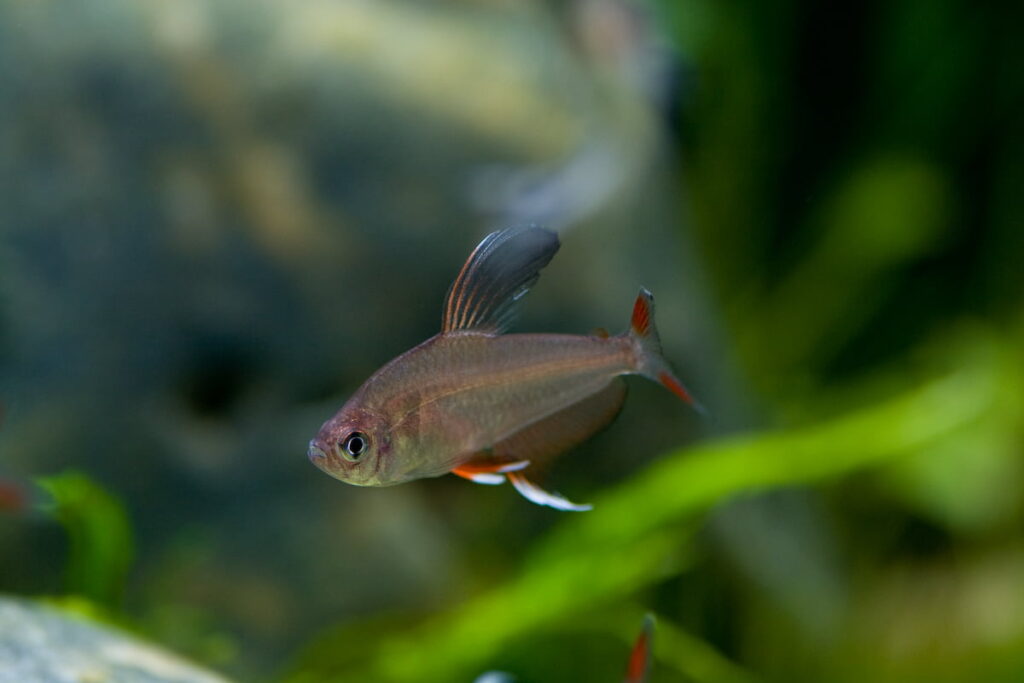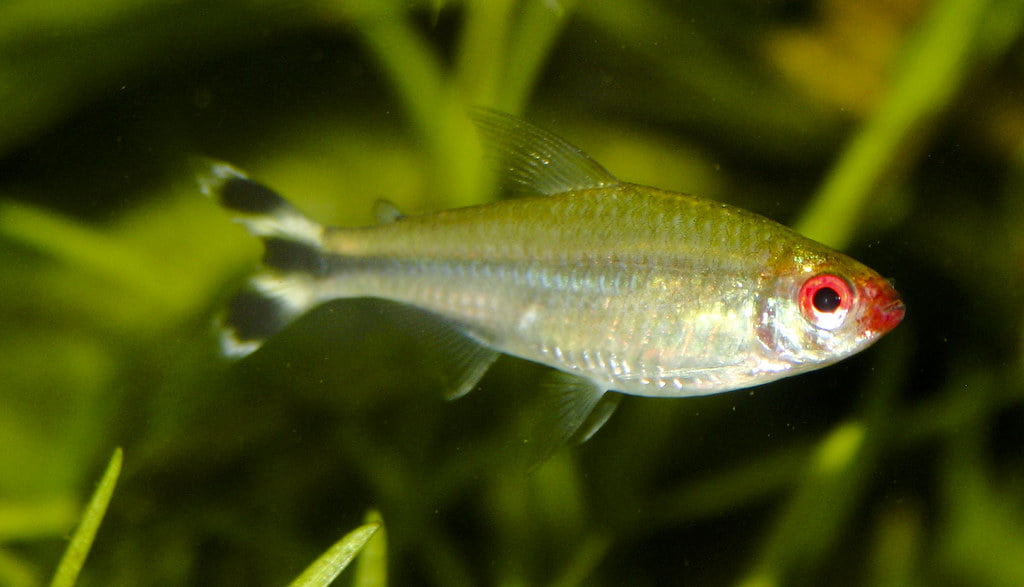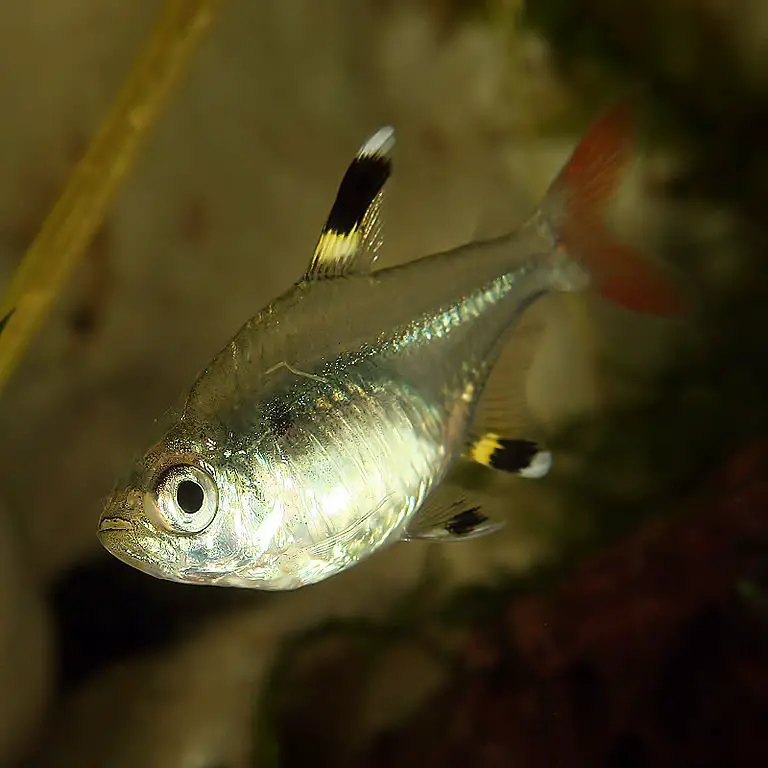Breeding GloFish Tetra, a captivating and vibrant aquarium fish, offers enthusiasts an opportunity to witness the continuation of this unique, genetically modified species. GloFish Tetras, derived from the Black Widow Tetra, boast dazzling fluorescent colors that add a striking allure to any tank. This guide provides a comprehensive walkthrough of the breeding process, shedding light on the equipment, techniques, and considerations essential for successful reproduction.
Whether you’re a hobbyist or an aspiring breeder, understanding the intricacies of breeding GloFish Tetra can deepen your appreciation for these enchanting aquatic creatures.
[Legal Note: GloFish Tetras are patented, and selling them commercially is prohibited. This guide strictly advocates responsible and lawful breeding practices for educational purposes only.] GloFish®
Quick Answer:
Breeding GloFish Tetra involves several key steps to ensure successful reproduction. First, create an ideal breeding environment within the aquarium, mimicking their natural habitat. Provide suitable hiding spots for the female GloFish Tetras to lay their eggs and for the fry to seek shelter. Stimulate breeding by adjusting the water conditions, including temperature and pH levels. With proper care and consideration, you can witness the joy of new life as GloFish Tetras breed and populate your aquatic world.
Is it Illegal to Breed GloFish Tetras?
Breeding GloFish Tetras is not illegal; however, selling the resulting GloFish Tetras may be subject to restrictions. GloFish Tetras are patented, and selling them without proper authorization could infringe on intellectual property rights. Understanding the legal aspects and ensuring compliance with the terms and conditions related to GloFish Tetra breeding and distribution is crucial.
For more information on international use and licensing, you can refer to the official GloFish website’s Legal and License Notice page GloFish Legal and License Notice.
Equipment You Will Require To Breed GloFish Tetra
- Aqua Culture 10 Gallon Aquarium Starter Kit
- Sponge Filter and Air Pump
- NICREW ClassicLED Aquarium Light
- Orlushy Submersible Aquarium
- Pawfly 4 Inch Aquarium Net Fine Mesh
- hygger Carbon Fiber 6 in 1 Aquarium Cleaning Tool Kit
- API Master Freshwater Test Kit
Now, let’s venture into the fascinating world of breeding GloFish Tetras. All your questions regarding the breeding process, from the prerequisites to the nitty-gritty details, will be thoroughly addressed as we progress through this article.
Whether you’re a curious enthusiast or an aspiring breeder, this comprehensive guide will give you the essential insights and steps to breed these vibrant aquatic companions successfully. Let’s dive into the intricacies of nurturing new generations of GloFish Tetras.
Step By Step Process to Breed GloFish Tetra
With the anticipation building and the groundwork set, we’re about to delve into the step-by-step process of breeding GloFish Tetra.
This journey unfolds in three significant phases: preparing for breeding, the actual breeding process, and the subsequent crucial care for the fry. It’s an exciting venture that promises new life and a deeper understanding of these remarkable fish.
Let’s seamlessly transition into each stage to ensure a successful and fulfilling experience in nurturing GloFish Tetra life within your aquarium.
Step 1: Preparing for Breeding
The initial phase of breeding GloFish Tetra requires careful planning and setting the right conditions for a successful breeding venture. Here, we’ll guide you through the essential steps to ensure everything is aligned before diving into the exciting breeding world.
Setting Up A Breeding Tank
Creating a suitable breeding environment is crucial for the health and safety of both the parent fish and the fry. Select a separate breeding tank, ideally 10 to 20 gallons, equipped with a heater and a gentle filtration system. I recommend an automatic heater and an air filter.
Provide ample hiding spots and plants to mimic a natural habitat and reduce stress for the breeding pair. Live plants will not only help the fish to hide but also mimic the natural environment in the aquarium.
Managing Water Parameters
Maintaining the correct water conditions is paramount for successful breeding.
Maintain the pH level of the water slightly on the acidic to neutral side, around 6.8 to 7.0. Keep the water temperature in the range of 72-79°F (22-26°C), similar to their natural habitat. This helps the fish feel comfortable and ready to breed.
An automatic heater is a handy tool for maintaining this temperature. Use a thermometer to monitor the temperature and make sure it stays consistent.
Ensure the water in the tank is clean and of good quality. Perform regular water changes to mimic the GloFish Tetras’ ideal breeding conditions. This keeps the environment suitable for breeding.
Include an air filter in the tank setup. Air filters are gentle and effective biological filters that help maintain the nitrogen cycle in the tank. They promote a healthy environment for the fish.
To jumpstart the nitrogen cycle, consider using API Quick Start. It helps in the process of establishing a healthy nitrogen cycle, which is important for the overall well-being of the fish.
Obtaining Quality Food
Ensuring the right nutrition for your GloFish Tetra fry is crucial for their growth and development. Like people, fish have different dietary needs at various stages of their life. Here’s how to anticipate their needs and provide suitable food options:
- For Newborn Fry:
Newborn fry are tiny and delicate, requiring specialized food options. Consider using micro foods like powdered fry food, Vinegar Eels, Infusoria, or Green Water. These options provide the essential nutrients and tiny particles needed for their initial growth. - For Juvenile Stage:
As the fry grow and transition into the juvenile stage, their dietary needs evolve. Offer food flakes, newly hatched brine shrimp, and microworms. These foods are more substantial and provide the necessary proteins and nutrients for their continued development. - For Adult and Parent Fish:
Adults and parents GloFish Tetras need a well-rounded and high-quality diet. Opt for premium fish food like Tetra Micro Pellets or Tetra Mini, which offer a balanced nutritional profile. These foods help maintain their health, vibrant coloration, and overall well-being.
Step 2: The Breeding Process
Selecting a Healthy Breeding Pair
The breeding journey of GloFish Tetras begins with carefully choosing a healthy pair. Follow these steps to ensure you have a robust foundation for the breeding process:
- Choose a Reliable Source:
Start by purchasing your GloFish Tetras from a reputable local pet store. Ensure the store has a good reputation for providing healthy and well-cared-for fish. - Identify Gender Differences:
If you’re uncertain about identifying the genders, there are some visual cues. Females are generally larger with a rounded belly. Males are more colorful, have pointed fins, and possess longer dorsal fins. Additionally, the female’s dorsal fin is curved and shorter. - Check for Health and Vitality:
Examine the fish for any signs of sickness, like fin rot or unusual swimming patterns. Ensure there are no deformities that might affect their ability to breed successfully. - Quarantine Your Fish:
After purchase, quarantine the newly acquired fish in a separate tank. This helps to ensure they are free from any potential illnesses or infections before introducing them to the breeding environment.
We have a full-detailed article on differentiating male and female GloFish Tetra, for full details check out the page.
Breeding Signs
Here are the 7 signs that your breeding pair is ready:
- Vibrant Colors:
Both the male and female GloFish Tetras display vibrant and intensified colors, indicating they are in optimal breeding conditions. - Active and Energetic Behavior:
The pair exhibits increased activity, chasing each other playfully. This heightened energy is a sign of readiness for breeding. - Flaring Fins and Displaying:
The male may flare its fins and display vibrant colors to attract the female, a classic courtship behavior. - Nesting Behavior:
The male may begin to build a bubble nest at the water’s surface or search for potential nest sites, showcasing nesting instincts. - Chasing and Courtship Rituals:
The male chases the female in a circular dance or zigzag pattern, indicating courtship and readiness for breeding. - Eager for Proximity:
The male may position himself near the female and try to stay close, showcasing a desire to initiate the breeding process. - Frequent Posing:
Both male and female assume specific postures, such as an S-shape or head-down position, during the courtship, signaling readiness.
Here is the full detailed article on how you can identify your GloFish Tetra is pregnant.
Egg Fertilization
After the courtship and readiness for breeding, female GloFish Tetras initiate the process by laying eggs in batches over a span of 3 to 4 days. Each day, a new batch of eggs is released, comprising approximately 100 eggs, although the quantity may vary.
The eggs are small, transparent, and adhesive, typically sticking to surfaces like plants or tank decorations within the breeding environment. The male GloFish Tetra, if present, promptly releases milt, a fluid containing sperm, fertilizing the eggs externally as the female releases them.
The adhesive nature of the eggs ensures they stay protected and attached to surfaces until they hatch. Maintaining ideal water conditions during this time is crucial to support successful fertilization and subsequent hatching.
The tank’s water parameters and overall conditions should mimic the natural habitat of GloFish Tetras, enhancing the chances of a successful fertilization process and the survival of the resulting fry.
Removing Breeding Pair
After successful egg fertilization, a critical step in the breeding process is the prompt removal of the breeding pair from the breeding tank. This step is crucial because, in the absence of separation, the parent fish, particularly the male GloFish Tetra, tend to consume the eggs.
The parents may not recognize the eggs as their own and may see them as a potential food source. Hence, removing the breeding pair helps in safeguarding the eggs from being eaten and ensures the possibility of successful hatching and fry survival.
One effective strategy to protect the eggs, in case immediate removal isn’t feasible, is to add a piece of craft mesh covering the tank’s bottom. This mesh acts as a barrier, trapping the eggs and preventing the parents from reaching and consuming them.
This practice enhances the chances of a higher egg survival rate and ultimately contributes to a successful breeding experience.
Monitoring Eggs
During the egg monitoring phase, it’s essential to keep a close eye on the developing eggs. As this process unfolds, you’ll begin to observe movement within the eggs, indicating the embryos are developing.
However, not all eggs will successfully develop. Some eggs may remain unfertilized or develop fungus, becoming cloudy in color. It’s crucial to promptly remove these unfertilized or fungus-infected eggs to maintain a healthy and conducive environment for the viable eggs to thrive. This selective removal helps in preventing potential contamination and ensures optimal conditions for the healthy development of the growing embryos.
Step 3: Caring For The Fry
Hatching Of The Egg
After about 2 to 3 days of incubation, you’ll witness the exciting moment of the eggs hatching. The newly born fry will still have the egg sac attached to their bodies, which provides initial nourishment. Initially, they tend to stay near the bottom of the tank, resting and adjusting to their newfound world. As they gradually consume the egg sac, they gain strength and vitality, enabling them to start exploring their surroundings within the fish tank. It’s a fascinating phase as the fry begin their journey, navigating the tank and embarking on their growth.
Feeding GloFish Tetra Fry
Moving on to feeding the GloFish Tetra fry, once they begin swimming independently and the egg sac is no longer visible, it’s time to provide them with suitable nourishment.
Opt for micro foods like powdered fry food, Vinegar Eels, Infusoria, or Green Water to ensure the fry receive essential nutrients that promote rapid and healthy growth.
As the fry transition from the early stages to juveniles and eventually adults, their dietary needs evolve. Each stage demands specific nutritional requirements. Adapting their diet accordingly as they grow is crucial to supporting their development and overall well-being.
Understanding and providing the right nutrition at each stage of their growth journey is key to raising healthy and vibrant GloFish Tetras.
Maintaining The Water Condition Of the Fry Tank
It’s crucial to create an environment that nurtures healthy growth. Aim for a slightly acidic to neutral pH range, ideally between 5.8 and 6.8, and maintain a moderate hardness level of 3 to 5 dGH (degrees of General Hardness). Keeping the temperature within a range of 75° to 80° F (24° to 27° C) ensures a comfortable habitat for the young fry.
Utilizing a sponge filter plays a pivotal role in maintaining excellent water quality within the tank. The sponge filter aids in biological filtration and gentle aeration, supporting the overall well-being of the fry.
Additionally, regular water changes are key to sustaining a clean and suitable environment. Aim for a 25-50% water change weekly to ensure optimal conditions for the growing fry, helping them thrive and develop robustly.
Related Article: How Long Do GloFish Tetra Live For?
Some of The Question Related to Breeding GloFish Tetra
How Often Do GloFish Breed?
GloFish Tetras can breed regularly, particularly during the rainy season or when provided with suitable breeding conditions.
Will GloFish Breed in a Community Tank?
Yes, GloFish Tetras can breed in a community tank, especially if the tank setup is conducive to their natural breeding behaviors. If you want to learn about the best tank mates for your GloFish Tetra, check out the page.
Will the Color of GloFish Remain the Same After Breeding?
Yes, the vibrant color of GloFish remains the same after breeding; breeding doesn’t alter their distinct colors.
At What Age Can GloFish Start Breeding?
GloFish Tetras typically reach breeding age when they are around 6-9 months old.
Can You Sell or Trade GloFish Offspring?
It’s important to note that GloFish, being patented, have restrictions. It’s illegal to sell or trade GloFish offspring without the appropriate permissions due to patent regulations. Refer to GloFish’s official guidelines for details.
Summing Up
In conclusion, breeding GloFish Tetras can be a rewarding and fascinating endeavor for any aquarist. By carefully preparing the breeding tank with the right water conditions and providing appropriate nutrition, you can set the stage for a successful breeding process. From selecting healthy pairs to monitoring the eggs and caring for the fry, each step is crucial. Remember, however, that GloFish Tetras are a patented species, and breeding and handling their offspring must adhere to legal guidelines. By following these steps and respecting the regulations, you can witness the marvels of life as new generations of GloFish Tetras brighten your aquarium, adding vibrancy to your aquatic world.
Related Article: How Many GloFish Tetra per Gallon of Water
